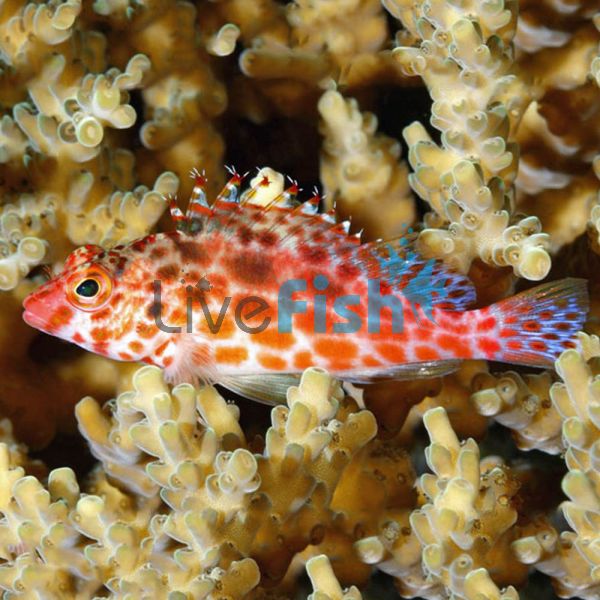Coral Hawkfish - Large
The Coral Hawkfish is a hardy fish with an enthusiastic personality. It is best suited to co-habiting with larger semi-aggressive or aggressive tank buddies. Coral Hawkfish has a whitish body and fins covered with red spots. The Coral Hawkfish has an aggressive temperament and may harass fish that are introduced to a tank after it.
The Coral Hawkfish
Coral Hawkfish has a whitish body and fins covered with red spots. The Coral Hawkfish has an aggressive temperament and may harass fish that are introduced to a tank after it.
Coral hawkfish are hermaphroditic, females are able to change sex if the group/harem requires a male. They are pelagic spawners, ascending into the water column to release their eggs.
While this species can show aggression to most other fish, this can be partially alleviated if it is kept well fed and the tank has plenty of hiding places and areas to shelter.
This species is quite easy to look after. They are hardy fish who do not easily fall ill.
In the wild, Coral Hawkfish can be found perched on reef rocks or corals, watching the surrounding area. Seaward reefs, lagoons, and channels are common natural habitats, to a depth of around 40 meters. Adults can grow to a length of 3.9 inches (10cm).
Its native habitat is in the Indo-Pacific, Eastern Pacific, and Central America.
Tank Recommendations for the Coral Hawkfish
The recommended minimum tank size for these fish is 30 gallons (113.5 liters).
They have a tendency to jump out of the tank, so a cover for your aquarium is a must.
This species is generally considered reef safe as they do not eat coral. However, they may use corals for perching which can damage more delicate varieties.
A suitable aquarium should have plenty of rock, with high levels of oxygenation and strong water movement.
Suitable Tank Buddies
Coral Hawkfish are aggressive and can show hostility to most fish. It is possible to house a mated pair if they are introduced together.
Usually Compatible
Larger semi-aggressive or aggressive fish are the most suitable tank buddies.
So large Angelfish, Batfish, Clownfish, Foxface/Rabbits, Jawfish, Puffers, and Tangs all work well.
Sometime Compatible
Use caution when housing Coral Hawkfish with Anglers/Frogfish, Boxfish, Grunts/Sweetlips, Triggers, and other Hawkfish.
Rarely Compatible
Avoid housing with small invertebrates, Seahorses, Pipefish, small Dottybacks, Butterflyfish, Pygmy Angelfish, Groupers, Eels, Lionfish, Scorpionfish, Sharks, or Rays.
The Coral Hawkfish has a distinctive color pattern and lively personality. They are hardy, disease-resistant, and suitable for beginners or experienced aquarists.
Feeding Your Coral Hawkfish
Coral Hawkfish are Carnivorous and in the wild, they will eat shellfish, shrimp, and fish larvae.
A suitable aquarium diet should consist of live mysis and brine shrimp, marine meat, and frozen preparations. It has a prodigious appetite and needs to be kept well fed on a daily basis or it may start feeding on smaller fish and crustaceans.
| Scientific Name | Cirrhitichthys oxycephalus |
|---|---|
| Care Level | Easy |
| Common Names | Coral Hawkfish, Pixie Hawkfish, Spotted Hawkfish |
| Diet | Carnivore |
| Fish Family | Cirrhitidae |
| Lifespan (years) | 6 |
| Max. Length (cm) | 10 |
| Min. Tank Volume (l) | 114 |
| Origin | Indo-Pacific, Eastern Pacific and Central America |
| Reef Safe | With Caution |
| Sociability | Aggressive |
| Venomous | No |
| Water Conditions | 22-25° C, dKH 8-12, pH 8.1-8.4, sg 1.020-1.025 |




